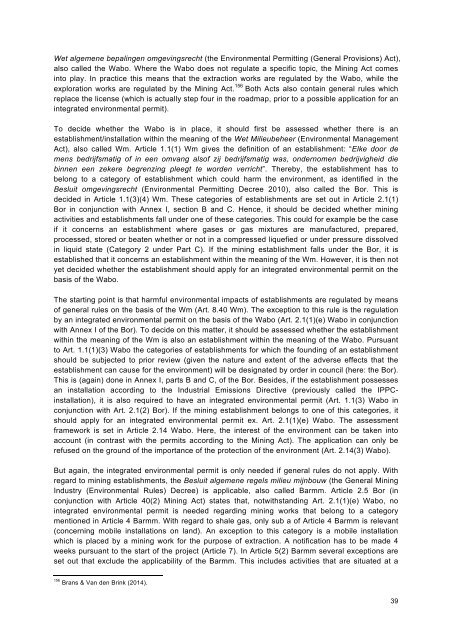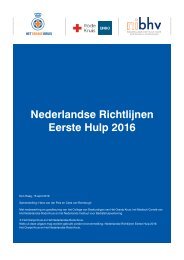Thesis-Anne-Vos-Masters-SBR-and-EU-Law-3
Thesis-Anne-Vos-Masters-SBR-and-EU-Law-3
Thesis-Anne-Vos-Masters-SBR-and-EU-Law-3
You also want an ePaper? Increase the reach of your titles
YUMPU automatically turns print PDFs into web optimized ePapers that Google loves.
Wet algemene bepalingen omgevingsrecht (the Environmental Permitting (General Provisions) Act),<br />
also called the Wabo. Where the Wabo does not regulate a specific topic, the Mining Act comes<br />
into play. In practice this means that the extraction works are regulated by the Wabo, while the<br />
exploration works are regulated by the Mining Act. 156 Both Acts also contain general rules which<br />
replace the license (which is actually step four in the roadmap, prior to a possible application for an<br />
integrated environmental permit).<br />
To decide whether the Wabo is in place, it should first be assessed whether there is an<br />
establishment/installation within the meaning of the Wet Milieubeheer (Environmental Management<br />
Act), also called Wm. Article 1.1(1) Wm gives the definition of an establishment: “Elke door de<br />
mens bedrijfsmatig of in een omvang alsof zij bedrijfsmatig was, ondernomen bedrijvigheid die<br />
binnen een zekere begrenzing pleegt te worden verricht”. Thereby, the establishment has to<br />
belong to a category of establishment which could harm the environment, as identified in the<br />
Besluit omgevingsrecht (Environmental Permitting Decree 2010), also called the Bor. This is<br />
decided in Article 1.1(3)(4) Wm. These categories of establishments are set out in Article 2.1(1)<br />
Bor in conjunction with <strong>Anne</strong>x I, section B <strong>and</strong> C. Hence, it should be decided whether mining<br />
activities <strong>and</strong> establishments fall under one of these categories. This could for example be the case<br />
if it concerns an establishment where gases or gas mixtures are manufactured, prepared,<br />
processed, stored or beaten whether or not in a compressed liquefied or under pressure dissolved<br />
in liquid state (Category 2 under Part C). If the mining establishment falls under the Bor, it is<br />
established that it concerns an establishment within the meaning of the Wm. However, it is then not<br />
yet decided whether the establishment should apply for an integrated environmental permit on the<br />
basis of the Wabo.<br />
The starting point is that harmful environmental impacts of establishments are regulated by means<br />
of general rules on the basis of the Wm (Art. 8.40 Wm). The exception to this rule is the regulation<br />
by an integrated environmental permit on the basis of the Wabo (Art. 2.1(1)(e) Wabo in conjunction<br />
with <strong>Anne</strong>x I of the Bor). To decide on this matter, it should be assessed whether the establishment<br />
within the meaning of the Wm is also an establishment within the meaning of the Wabo. Pursuant<br />
to Art. 1.1(1)(3) Wabo the categories of establishments for which the founding of an establishment<br />
should be subjected to prior review (given the nature <strong>and</strong> extent of the adverse effects that the<br />
establishment can cause for the environment) will be designated by order in council (here: the Bor).<br />
This is (again) done in <strong>Anne</strong>x I, parts B <strong>and</strong> C, of the Bor. Besides, if the establishment possesses<br />
an installation according to the Industrial Emissions Directive (previously called the IPPCinstallation),<br />
it is also required to have an integrated environmental permit (Art. 1.1(3) Wabo in<br />
conjunction with Art. 2.1(2) Bor). If the mining establishment belongs to one of this categories, it<br />
should apply for an integrated environmental permit ex. Art. 2.1(1)(e) Wabo. The assessment<br />
framework is set in Article 2.14 Wabo. Here, the interest of the environment can be taken into<br />
account (in contrast with the permits according to the Mining Act). The application can only be<br />
refused on the ground of the importance of the protection of the environment (Art. 2.14(3) Wabo).<br />
But again, the integrated environmental permit is only needed if general rules do not apply. With<br />
regard to mining establishments, the Besluit algemene regels milieu mijnbouw (the General Mining<br />
Industry (Environmental Rules) Decree) is applicable, also called Barmm. Article 2.5 Bor (in<br />
conjunction with Article 40(2) Mining Act) states that, notwithst<strong>and</strong>ing Art. 2.1(1)(e) Wabo, no<br />
integrated environmental permit is needed regarding mining works that belong to a category<br />
mentioned in Article 4 Barmm. With regard to shale gas, only sub a of Article 4 Barmm is relevant<br />
(concerning mobile installations on l<strong>and</strong>). An exception to this category is a mobile installation<br />
which is placed by a mining work for the purpose of extraction. A notification has to be made 4<br />
weeks pursuant to the start of the project (Article 7). In Article 5(2) Barmm several exceptions are<br />
set out that exclude the applicability of the Barmm. This includes activities that are situated at a<br />
156<br />
Brans & Van den Brink (2014).<br />
39



